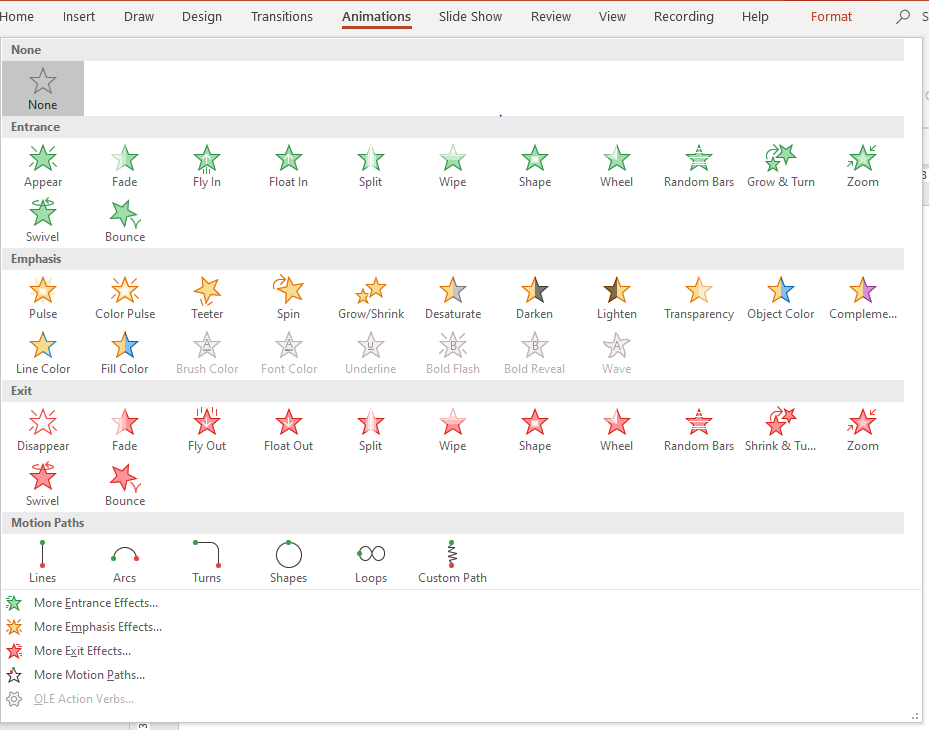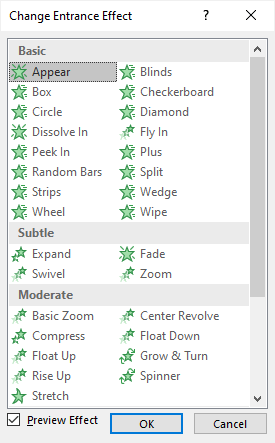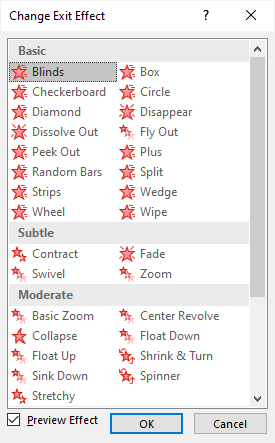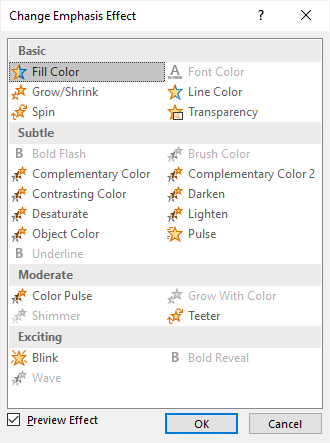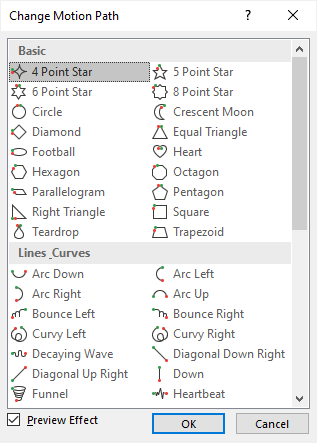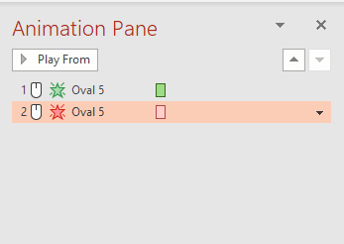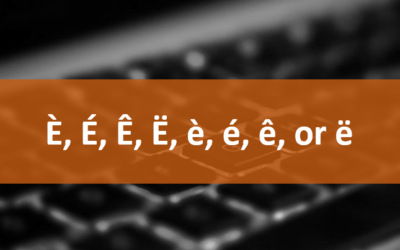Add Animation in PowerPoint to Create More Engaging Presentations
by Avantix Learning Team | Updated August 8, 2023
Applies to: Microsoft® PowerPoint® 2013, 2016, 2019, 2021 and 365 (Windows)
You can add animation to pictures, text and other objects in PowerPoint to create more engaging presentations. Animations can be entrance, exit, emphasis or motion path and can start on click or automatically when you run a slide show. Since animations add movement, they can help to focus attention. The key is to engage, not distract, your audience. You can add animation in Normal View or Slide Master View.
Recommended article: 10 Ways to Compress PowerPoint Presentations to Reduce File Size
Do you want to learn more about PowerPoint? Check out our virtual classroom or in-person classroom PowerPoint courses >
There are 4 types of animation in PowerPoint:
- Entrance
- Exit
- Emphasis
- Motion Path
Although you can also apply transitions between slides in PowerPoint (like Morph), transitions are different from animations and occur between slides when you run a slide show.
Add animation using the Animations Gallery
The easiest way to apply a single animation effect is to use the Animations Gallery on the Animations tab in the Ribbon:
The expanded Animations Gallery appears when you click the More down arrow:
Add multiple animations to an object
If you are adding more than one animation effect to an object, you must use the Add Animation command in the Advanced Animations group, not the Animations Gallery.
Add an entrance animation
The most common type of animation to add to an object is an entrance animation. Common entrance animations are Fade, Fly In or Wipe.
To add an entrance animation to a picture, shape or other object:
- In Normal View or Slide Master View, select a picture, shape or other object. For text objects, click in the text box or placeholder or click its edge.
- Click the Animations tab in the Ribbon.
- In the Animations group, click the More down arrow on the bottom right of the Animations Gallery.
- Click an entrance animation in the Entrance group.
- If you would like to select an entrance effect that does not appear in the Entrance group, click More Entrance Effects at the bottom of the gallery. A dialog box appears.
- Click the entrance effect you want to apply.
- Click OK.
You can also apply an entrance animation by clicking Add Animation on the Animations tab in the Advanced Animation group.
The Change Entrance Effect dialog box includes several other entrance animations (some are only available in specific versions):
Add an exit animation
You can also add exit animations to objects. Common exit animations are Fade, Fly-Out or Disappear.
To add an exit animation to a picture, shape or other object:
- In Normal View or Slide Master View, select a picture, shape or other object. For text objects, click in the text box or placeholder or click its edge.
- Click the Animations tab in the Ribbon.
- In the Animations group, click the More down arrow on the bottom right of the Animations Gallery.
- Click an exit animation in the Exit group.
- If you would like to select an exit effect that does not appear in the Exit group, click More Exit Effects at the bottom of the gallery. A dialog box appears.
- Click the exit effect you want to apply.
- Click OK.
You can also apply an exit animation by clicking Add Animation on the Animations tab in the Advanced Animation group.
The Change Exit Effect dialog box includes several other exit animations (some are only available in specific versions):
Add an emphasis animation
You can apply emphasis animations to some objects in PowerPoint. Emphasis animations are normally used for text, shapes or images. Common emphasis animations are Grow/Shrink, Fill Color or Font Color. Emphasis animations are enabled only for the type of object you select. For example, you can only apply Font Color to a text object.
To add an emphasis animation to a picture, shape or other object:
- In Normal View or Slide Master View, select a picture, shape or other object. For text objects, click in the text box or placeholder or click its edge.
- Click the Animations tab in the Ribbon.
- In the Animations group, click the More down arrow on the bottom right of the Animations Gallery.
- Click an emphasis animation in the Emphasis group.
- If you would like to select an emphasis effect that does not appear in the Emphasis group, click More Emphasis Effects at the bottom of the gallery. A dialog box appears.
- Click the emphasis effect you want to apply.
- Click OK.
You can also apply an emphasis animation by clicking Add Animation on the Animations tab in the Advanced Animation group.
The Change Emphasis Effect dialog box includes several other emphasis animations (some are only available in specific versions and for certain types of objects):
Add a motion path animation
A motion path is a path that is followed during an animation. For example, you can have an object move along a straight line path down and to the right on a slide.
To add a motion path animation to a picture, shape or other object:
- In Normal View or Slide Master View, select a picture, shape or object.
- Move the picture, shape or object you want to animate to the desired starting location.
- Select the picture, shape or object. For text objects, click in the text box or placeholder or click its edge.
- Click the Animations tab in the Ribbon.
- In the Animations group, click the More down arrow on the bottom right of the Animations Gallery.
- Click a motion path animation in the Motion Paths group.
- If you would like to select a motion path effect that does not appear in the Motion Paths group, click More Motion Path Effects at the bottom of the gallery. A dialog box appears.
- Click the motion path effect you want to apply.
- Click OK. A path will appear. In 2013 and later versions, a second copy of the object appears.
- Depending on the type of motion path you selected, drag the end copy or point to a new location.
You can also apply a motion path animation by clicking Add Animation on the Animations tab in the Advanced Animation group.
Motion paths can be used in advanced animation sequences. In this article, we are focusing on simple motion paths.
To resize or redirect a motion path:
- Drag the green start point to a new location.
- Drag the red end point to a new location.
The Change Motion Path dialog box includes several other motion path animations:
Preview animation effects
After you add an animation effect, you can click the Preview or Play button on the Animations tab in the Ribbon to preview it. You can also preview animations by running a slide show (click the Slide Show button on the bottom right of your screen). By default, animations are set to play on click.
Set Effect Options
You can also set different Effect Options for animations. Effect Options change depending on the animation effect you selected. For example, if you selected the Fly In entrance effect, options would include From Top, From Left, From Right and so on.
To set an effect option for an animation effect:
- Select a picture, shape or object. For text objects, click in the text box or placeholder or click its edge. We'll assume here that there is one animation applied to the object.
- Click the Animations tab in the Ribbon.
- Click Effect Options. A drop-down menu appears.
- Click an option.
The following Effect Options appear for the Fly In animation:
Control the way animations start
Although animations are set by default to start on click, you can start them in other ways.
To control the way an animation starts:
- Select a picture, shape or object. For text objects, click in the text box or placeholder or click its edge. We'll assume here that there is one animation applied to the object.
- Click the Animations tab in the Ribbon.
- In the Animations group, select an option from the Start drop-down menu in the Timing group. You can select On Click, With Previous or After Previous. With Previous or After Previous will run based on a previous animation.
Note the Start setting is set by default to On Click:
Control the speed or duration of animations
When you apply an animation, a duration or speed is automatically set for the animation (in seconds). The default duration is different for each animation effect. The initial duration is often fast and you may want to increase the duration to slow it down.
To set a speed or duration of an animation:
- Select an picture, shape or object. For text objects, click in the text box or placeholder or click its edge. We'll assume here that there is one animation applied to the object.
- Click the Animations tab in the Ribbon.
- In the Animations group, enter a time for the animation in the Duration area of the Timing group. You can click the up and down arrows to change the duration or type a duration.
Note the Duration in the example below:
Editing animations using the Animation Pane
When you apply multiple animations to an object, it's best to display the Animation Pane so you can easily edit the animations.
To edit animations using the Animation Pane:
- Click the Animations tab in the Ribbon.
- Click Animation Pane in the Advanced Animations group. The Animation Pane appears on the right side of the screen.
- Click the animation effect you want to edit.
- Select the desired options on the Animations tab in the Ribbon or click the down arrow to the right of the animation effect and select options for the animation. You can also select Effect Options and choose more options in the Effect Options dialog box.
The Animation Pane will display the animations you have applied. If you have applied an entrance and exit effect, two animation effects will appear in the Animation Pane. You can click the animation effect in the Animation Pane and click the arrow to the right to display a drop-down menu with options or you can select options in the Ribbon for that effect.
In the Animation Pane, a green star appears beside entrance animations and a red star appears beside exit animations as follows:
Remove animations
To remove animations from pictures, shapes or objects on a slide:
- Select a picture, shape or object. For text objects, click in the text box or placeholder or click its edge.
- Shift-click any other objects with animations you want to remove.
- Click the Animations tab in the Ribbon.
- In the Animations group, click None in the Animations Gallery.
Animation can help engage your audience and focus attention and it's not difficult to use in PowerPoint presentations.
Subscribe to get more articles like this one
Did you find this article helpful? If you would like to receive new articles, JOIN our email list.
More resources
How to Insert Slide Numbers in PowerPoint
How to Make an Object Appear and Disappear in PowerPoint
How to Quickly Remove All Animations in PowerPoint Presentations
How to Use Morph in PowerPoint to Design Engaging Presentations
How to Remove the Background of an Image in PowerPoint (2 Ways)
Related courses
Microsoft PowerPoint: Intermediate / Advanced
Microsoft PowerPoint: Design for Non-Designers
Microsoft PowerPoint: Animations Bootcamp
Our instructor-led courses are delivered in virtual classroom format or at our downtown Toronto location at 18 King Street East, Suite 1400, Toronto, Ontario, Canada (some in-person classroom courses may also be delivered at an alternate downtown Toronto location). Contact us at info@avantixlearning.ca if you'd like to arrange custom instructor-led virtual classroom or onsite training on a date that's convenient for you.
Copyright 2024 Avantix® Learning
You may also like
How to Insert or Type E with an Accent Mark in PowerPoint (È, É, Ê, Ë, è, é, ê, or ë)
You can insert or type e with an accent mark in PowerPoint using built-in tools or keyboard shortcuts (including Alt code shortcuts). The letter e can be inserted with an accent in both upper or lower case in text boxes or placeholders on slides, the slide master or layouts. The following are common accents in upper or lower case – È, É, Ê, Ë, è, é, ê, or ë.
How to Fade a Picture or Part of a Picture in PowerPoint (Using a Gradient)
You can fade a picture in PowerPoint by drawing a rectangle shape on top of the picture and then filling the rectangle with a gradient from opaque to transparent. This technique is often used to fade an image into the background of a slide. Since the rectangle is placed on top of the image and then text may be placed on top of the rectangle, you may need to reorder the objects.
How to Lock an Image, Shape or Other Object in PowerPoint
You can now lock an image, shape or other object in PowerPoint. Objects can be locked in Normal View or Slide Master View. Only PowerPoint 365 users can lock objects to prevent moving and resizing. This is helpful if you want to select and move other objects on the slide or prevent others from moving or resizing an object. You can lock items using the context menu or the Selection Pane.
Microsoft, the Microsoft logo, Microsoft Office and related Microsoft applications and logos are registered trademarks of Microsoft Corporation in Canada, US and other countries. All other trademarks are the property of the registered owners.
Avantix Learning |18 King Street East, Suite 1400, Toronto, Ontario, Canada M5C 1C4 | Contact us at info@avantixlearning.ca



